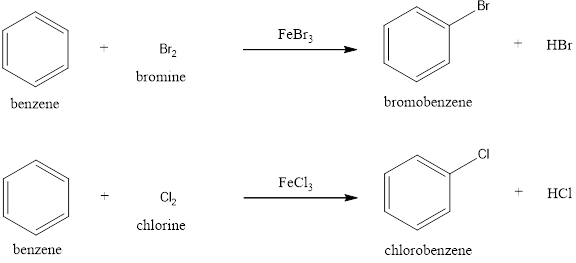
Concept explainers
(a)
Interpretation:
The missing reactant in the given conversion has to be identified.
Concept Introduction:
Alkylation:
Benzene undergoes alkylation reaction in presence of

Halogenation:
Benzene undergoes halogenation reaction in presence of

(c)
Interpretation:
The missing reactant in the given conversion has to be identified.
Concept Introduction:
Aromatic hydrocarbons undergo substitution reactions rather than addition reactions. Even though the aromatic hydrocarbon has double bonds in its structure, they undergo substitution reaction only because the double bonds are involved in delocalized bonding that is present in the ring system.
Alkylation:
Benzene undergoes alkylation reaction in presence of

Halogenation:
Benzene undergoes halogenation reaction in presence of

(c)
Interpretation:
The missing product in the given conversion has to be identified.
Concept Introduction:
Aromatic hydrocarbons undergo substitution reactions rather than addition reactions. Even though the aromatic hydrocarbon has double bonds in its structure, they undergo substitution reaction only because the double bonds are involved in delocalized bonding that is present in the ring system.
Alkylation:
Benzene undergoes alkylation reaction in presence of

Halogenation:
Benzene undergoes halogenation reaction in presence of

Trending nowThis is a popular solution!

Chapter 13 Solutions
EBK GENERAL, ORGANIC, AND BIOLOGICAL CH
- What is the name of the following compound? SiMe3arrow_forwardK Draw the starting structure that would lead to the major product shown under the provided conditions. Drawing 1. NaNH2 2. PhCH2Br 4 57°F Sunny Q Searcharrow_forward7 Draw the starting alkyl bromide that would produce this alkyne under these conditions. F Drawing 1. NaNH2, A 2. H3O+ £ 4 Temps to rise Tomorrow Q Search H2arrow_forward
 Organic And Biological ChemistryChemistryISBN:9781305081079Author:STOKER, H. Stephen (howard Stephen)Publisher:Cengage Learning,
Organic And Biological ChemistryChemistryISBN:9781305081079Author:STOKER, H. Stephen (howard Stephen)Publisher:Cengage Learning, General, Organic, and Biological ChemistryChemistryISBN:9781285853918Author:H. Stephen StokerPublisher:Cengage Learning
General, Organic, and Biological ChemistryChemistryISBN:9781285853918Author:H. Stephen StokerPublisher:Cengage Learning Chemistry: The Molecular ScienceChemistryISBN:9781285199047Author:John W. Moore, Conrad L. StanitskiPublisher:Cengage Learning
Chemistry: The Molecular ScienceChemistryISBN:9781285199047Author:John W. Moore, Conrad L. StanitskiPublisher:Cengage Learning Chemistry: Principles and PracticeChemistryISBN:9780534420123Author:Daniel L. Reger, Scott R. Goode, David W. Ball, Edward MercerPublisher:Cengage LearningChemistry: Matter and ChangeChemistryISBN:9780078746376Author:Dinah Zike, Laurel Dingrando, Nicholas Hainen, Cheryl WistromPublisher:Glencoe/McGraw-Hill School Pub Co
Chemistry: Principles and PracticeChemistryISBN:9780534420123Author:Daniel L. Reger, Scott R. Goode, David W. Ball, Edward MercerPublisher:Cengage LearningChemistry: Matter and ChangeChemistryISBN:9780078746376Author:Dinah Zike, Laurel Dingrando, Nicholas Hainen, Cheryl WistromPublisher:Glencoe/McGraw-Hill School Pub Co





